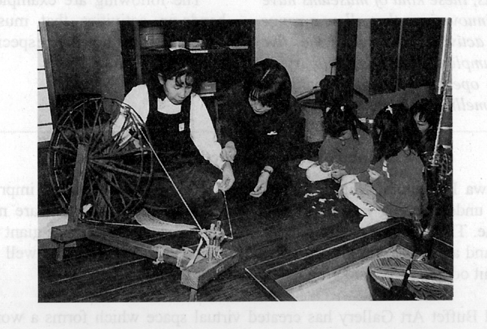| Home > Policy > White Paper, Notice, Announcement > White Paper > Japanese Government Policies in Education, Science, Sports and Culture1999 > Part2 Q44 | ||
A:Recently,there has been an increase in mu-seums that have introduced hands-on activi-ties.Rather than simply looking at the materi-als and exhibits,these kind of museums haveincorporated innovations that allow a rangeof hands-on activities involving the fivesenses,for example touching exhibits,tryingone's hand at operating exhibits,trying onexhibits and smelling and tasting exhibits.
An important role for museums in the future will be to arouse intellectual curiosity in children and provide opportunities for independent hands-on learning through these kinds of activities.The following are examples of a variety of hands-on activities that museums have been developing using their special functions and features.
O The Kanagawa Prefectural Museum of Natural History has developed impressive exhibits that deepen understanding by providing a variety of experiences that are not possible by looking alone.They include actually touching many specimens such as giant meteorites,an-cient rocks and ammonite fossils to experience their weight and feel,as well as smelling in-sects that emit odors and considering the reasons for the odor.O The Bernard Buffet Art Gallery has created virtual space which forms a world of pictures,and developed activities that make art fun and familiar and communicate the joy of creativity.Visitors can try on the clothes worn by the people in the pictures and experience their histori-cal background and atmosphere.O The Chikatsu Asuka Museum in Osaka has introduced activities that include reproducing the toys of the past for parents and children to play with and making and trying on the clothes of the day.The activities have been developed so that they do not simply play with toys and try on the clothes but also consider the meaning of play,and why those clothes were needed at the time and the history of their functional development, |
The Enjoyable Museum Project
In order to support these kinds of museum ac-tivities,MESSC initiated the Enjoyable Museum Project in FY1999.The project gathers ideas about exhibit development and educational ac-tivities for young people to enjoy using mu-seums from all over the country and implements the outstanding projects.The promotion of hands-on activities that allow children to learn about the principles of natural sciences,technologies and historical and traditional culture through experience,such as hands-on exhibit activities,activities involving the production of traditional crafts and joint ac-tivities between museums and schools,is aimed at increasing the number of museums that make children want to visit them.
Hands-on refers to learning through practical experience and is used in everyday language in Europe and America.The focus is on learners learning actively and independently rather than the teacher one-sidedly instilling knowledge.In museums,hands-on activities are those that involve using the five senses(touch,taste,smell,hearing and sight)rather than simply looking at exhibits and specimens,and evoke emo-tions of surprise,enjoyment,contemplation over how things work and wonder through touching,playing with,experimenting with and operating the exhibits. |

| Back to Top | MEXT HOME |